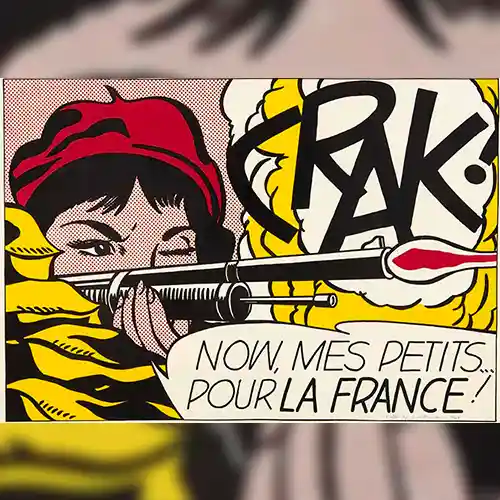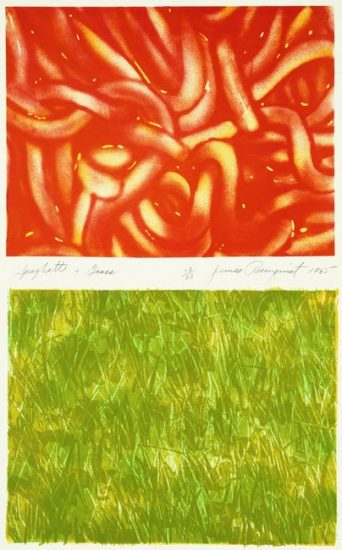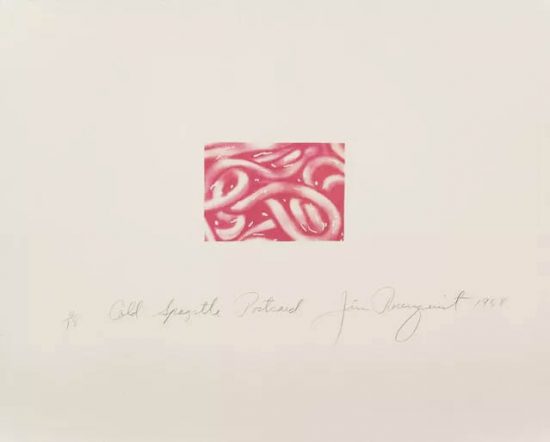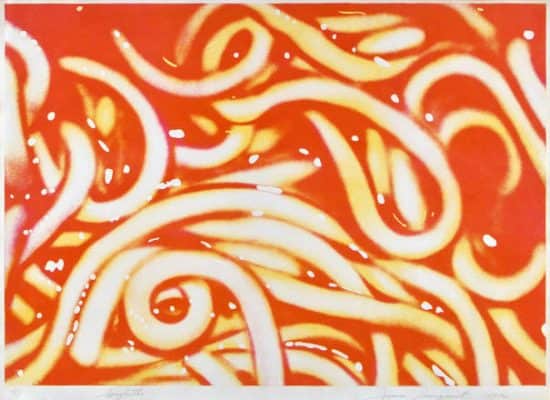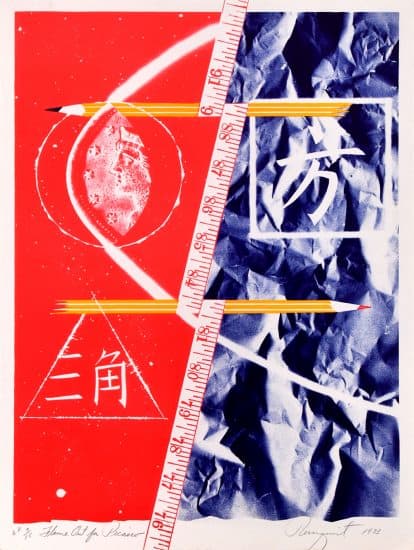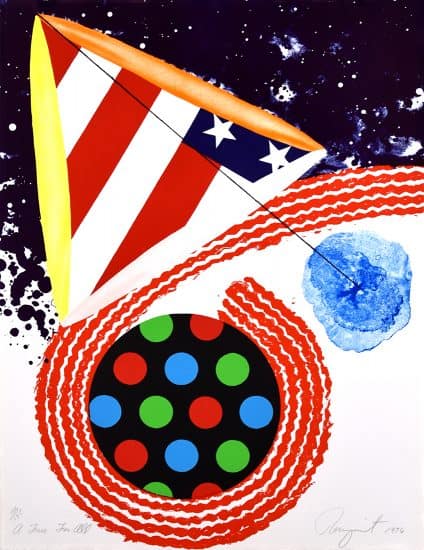Pop art has become synonymous with bold lines, bright colors, and cartoonish references through their repetitive use from artists such as Roy Lichtenstein, Andy Warhol, and James Rosenquist. The idea of comic books and television created a genre for artists such as James Rosenquist to bask in the delights of the art world and use his techniques in large scale murals. He initially found fame in his rather large work “F-111", which is one of the largest (86 feet) paintings to be shown in a modern gallery to date with others to follow. “F-111” was the largest seen painting when it was shown.
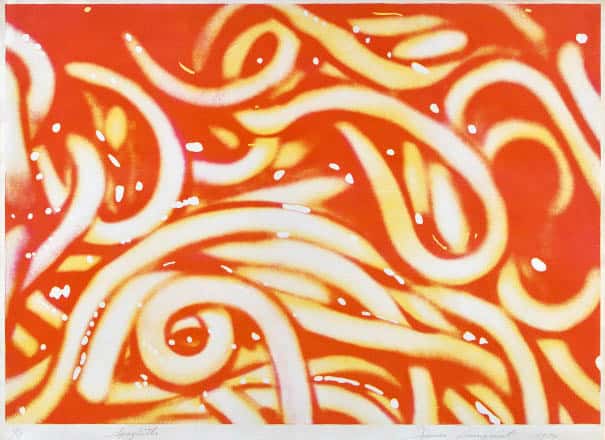
James Rosenquist was also known for bold lithographs such as his 1970 work “Spaghetti”, featuring red orange and yellow swirling coils representative of American-style spaghetti noodles. It is a massively motivated mural measuring 32 feet long and 8 feet high, which he created in 1965. Rosenquist's use of bright, vivid colors is also a hallmark of his style. In all of his works he uses such colors to create a visually stunning composition that is both playful and thought-provoking. Contrasting the primary color theory and darker themes aids in the performance of the piece’s success. Overall, "Spaghetti" is a sublime example of Rosenquist's innovative approach to painting and his willingness to challenge the traditional boundaries of painting. “Spaghetti” remains one of the most iconic works of Pop Art to this day.

Throughout his collection of works is the theme of capitalism, war, government control, and consumerism which Rosenquist amalgamates into the form of F-111 (named after the American Fighter-bomber) and into other lithographs. Like "Spaghetti," "F-111" uses fragmented and overlapping images to create a sense of movement and disorientation. The F-111 itself is mostly obscured by images of consumer goods, drawing a not-so-hazy connection between war and consumerism- Rosenquist's special brand of controversy sprinkled over his work.
Flying through the flak of consumer society to question the collusion between the Vietnam death machine, consumerism, the media, and advertising.
James Rosenquist

Rosenquist created "President Elect" during American president John F. Kennedy’s campaigning era to showcase the new President of the USA as the first man to take advantage of marketing in the modern era. The artist uses the image of one of Kennedy’s own campaign advertisements for character accuracy.
The cheesy smile coupled with a bite of cake on a fork suggests the easy to digest sweetness of the president elect.
Kennedy’s cookie-cutter brand is evident in the simplistic collage and highlights the idealistic American dreams of cars and confections.
James Rosenquist invites aspects of the Dada movement into his art, namely the focus on the horrors of war, American Government, and chaos transformed through artistic expression. Wartimes play a large part in the cycle of art and oftentimes is commissioned by the victors of the war to paint their achievements in a more noble light, but Rosenquist takes the opposite approach and questions the morality of government, war, and society in America.
To create such iconic works, the artists had to use various methods and techniques to get his paintings up to par. Rosenquist used the collage technique to create "F-111," which involved cutting out pictures from magazines, newspapers, and the like, then piecing them together to create a larger, more complex composition. He then transferred the collage onto the canvas using a silk-screening process, allowing the enormous scale of the painting.
To create the colossal scenes of various comic-like scenes James Rosenquist uses the technique scaling-up to draw his subject. It is the process of taking a smaller version of the chosen subject or scene, then squaring it away to translate each individual square for a 1-1 ratio and size difference. Rosenquist used this and other techniques to achieve the colossal size of his works. This decision to create larger than life paintings was a direct correlation to his work as an advertisement painter. Rosenquist spent much of his life painting billboard ads before he transitioned into the world of pop art. Though he kept the boldness of his previous lifework, the subjects began to differ in their political and social meaning. The smooth techniques of ad-style painting were kept to create the printed illusion on his works such as Spaghetti, Busy Signal, and F-111.
For example, in “Busy Signal”, the bold lines and chunky coloring do not translate into a simple message designed to reel viewers in. Instead the complexity of overlapping components completed by the artist lure the viewer into a world of pigment and thought-provoking design. Contrasting elements of black and red -two sides of the same coin- to create the communicative device we see in the center of the split frame. The continual consumeristic qualities we’ve observed in other of Rosenquist's works prevail here, though more inspired by billboards and communication.
Although inspired by billboard painting, Rosenquist does not include the ease of viewing which ads possess. Amalgamations of color and collaged images confuse and befuddle the viewer, requiring a prolonged viewing experience to understand the art in front of them. Billboards gave Rosenquist an appreciation for the power within advertising, and the role of consumer culture shaping American society in his time. He was intrigued by the way that ads, images, and slogans were used to manipulate people's desires and shape their hollow beliefs.
Overall, James Rosenquist's body of work is materialized through his use of bright coloring, fragmented imagery, and a sense of playful critiques of government. War, consumerism, capitalism, continue to be influential in art we know today. His background gave him a unique perspective on the power of advertising that allowed him to develop his unique style that was both innovative and accessible to a wide audience, resulting James Rosenquist's status as a must-see Pop Artist.
Enjoy our collection of James Rosenquist's Pop Art.
Citations
Guggenheim. “Collage and Scaling-Up.” The Guggenheim Museums and Foundation, 2022, https://www.guggenheim.org/teaching-materials/james-rosenquist-a-retrospective/collage-and-scaling-up .
NSW. “Spaghetti, 1970 by James Rosenquist.” , 1970 By James Rosenquist | Art Gallery of NSW, 2000, https://www.artgallery.nsw.gov.au/collection/works/83.1991/#details .
MOMA. “James Rosenquist. F-111. 1964-65: Moma.” The Museum of Modern Art, 2019, https://www.moma.org/collection/works/79805 .
James Rosenquist Foundation. “F-111: CONTEMPORARY HISTORY PAINTING.” F-111 - James Rosenquist Studio, 1979, https://www.jamesrosenquiststudio.com/page/f-111 .
James Rosenquist Foundation. “President Elect.” F-111 - James Rosenquist Studio, 1960, https://www.jamesrosenquiststudio.com .

